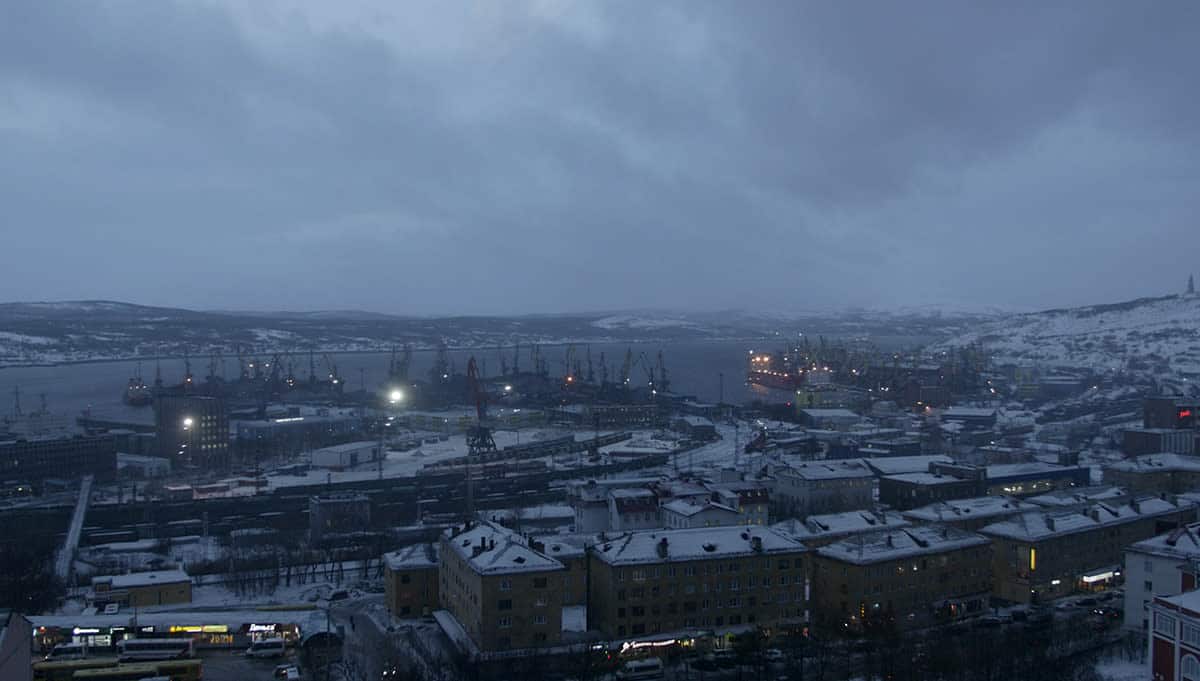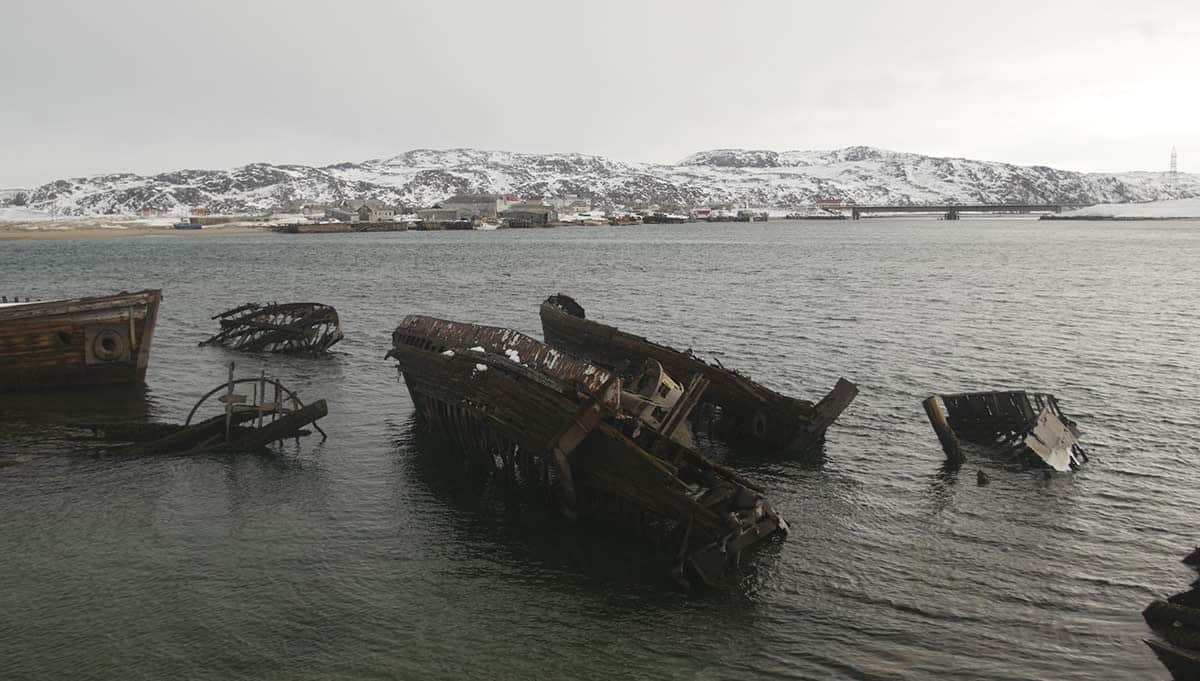Sometimes, when temperatures drop deep below zero in Murmansk, the waters fed by the North Cape Gulf Stream begin to steam. The port becomes a misty sauna, surrounded by Siberian cold for hundreds of kilometres. The German artist Marcel Weber, also known as MFO, witnessed this firsthand when he traveled to the isolated city in 2017. In collaboration with musician Liz Harris, Weber was there to create a site-specific, audiovisual contemplation on life in Murmansk.
The result, After its own death, is an experimental film that draws its title from a Mike Kelley essay on art after the death of art. Weber was sent north on a commission from the Unsound Dislocation project, which is a joint initiative by the Goethe Institute and the avant-garde music and art festival Unsound. The Dislocation project has travelled across 11 cities in the former USSR and Central Asia. After its own death featured a collaboration between Unsound, the Goethe Institute and London’s Barbican Centre.
“Apart from producing mini festivals in each location, I tried to commission a work tied to each place in some way,” curator Mat Schulz tells Format Magazine via email. Sometimes that meant initiating a collaboration between local and international artists. “Or it meant bringing artists to create a work that was a response to the place.” That’s how Weber and Harris ended up in Russia.
“While I was in Murmansk on my first visit, I was listening to a lot of Grouper’s music,” says Schulz. “It seemed to fit the place in late November.” He also took photos, which he later posted to Instagram. After noticing that Harris, who makes music under the names Grouper and Nivhek, was liking his photos, he began emailing her about the city. It was through those conversations that the idea to commission an audiovisual work in Murmansk was conceived. “I asked if she’d like to be involved, and she replied that she’d always been fascinated by Russia, the far north, abandoned architecture, and was interested,” says Schulz.

Aerial view of Murmansk.
As for Weber, he’s been collaborating with Schulz and the team at Unsound Krakow for over a decade. He has scored and directed films, engineered lighting and stage design for festivals, and also orchestrated live visual performance graphics. Schulz felt that Weber would be able to capture the visual essence of the city. “It was the place that inspired the idea of these artists collaborating—an idea that didn’t exist until going there,” says Schulz.
As part of the Unsound Dislocation project, Schulz visited Murmansk in November 2015. The remote city is located near the Norwegian border, in the far reaches of north-eastern Russia. It sits on the edge the Barents Sea, over 200 kilometers north of the Arctic Circle. “It was so cold and harsh,” says Schulz. “I couldn’t imagine how someone could live there.” But after meeting some young art curators bent on exploring remote urban peripheries, Schulz changed his outlook. “They spoke of Murmansk and the abandoned architecture, and they made me see it as special and unique, rather than some distant place,” says Schulz. Integrating his new view of Murmansk with the Dislocation project proved a natural development.
After individually visiting the site, and sharing their thoughts via email and Skype, Weber and Harris went to Murmansk together to begin their work. Despite language barriers and cultural isolation, Weber says the people of Murmansk were friendly, even in the face of his camera. He estimates that about 80 percent of the people he approached agreed to be filmed. “That is quite outstanding,” he says. “Usually people don’t want to be filmed.” Armed with a pre-translated text on his mobile phone, Weber communicated as best he could, and filmed almost everything he saw.
With no clear goal in mind, Weber began casually walking around the city filming his experiences. Influenced by films made in the 1970s and 1980s by French cinematographers like Chris Marker, Weber sought to create a distinctly Murmansk experience inspired by his own perception. “[Marker’s films] were more like free-flowing observations of places, but at the same time with a certain humanity and warmth to them,” says Weber. “I was impressed by that style and it definitely influenced how I shot [the work].” Not unlike Marker’s films, Weber’s film was created more for the world beyond Murmansk than for the city’s own residents, with the hope of sharing an impression of a unique place that’s not as alien as viewers might assume.
Weber’s slow cinematic approach builds on the impactful experiences he had with the people and environments around him while filming in the Arctic Circle. One such ordeal was his journey to Teriberka, a semi-abandoned fishing village located six hours northwest of Murmansk, on the edge of the Barents Sea. When Weber’s original Jeep-driving tour guide cancelled for the second time, Murmansk native Evgeni was hired instead. A local taxi driver, Evgeni brought him there in his two-wheel drive Toyota.
Although the roads immediately surrounding Murmansk are established and safe, they quickly turn to rough pathways before degrading to a sheet of compressed ice as Murmansk disappears in the distance. Driving beyond the city limits can quickly become perilous.

Image via Oleg Khadartsev and Aleksandr Alekseev.
Orange poles flanked their path, as the two struggled to maintain visibility in the face of a blizzard. “[Evgeni] was pretty confident and committed to the task, even though there were gusts of wind blowing massive pieces of snow and ice over the road,” says Weber. “But I have to admit, there were times where he was leaning over his steering wheel, his eyes were squinting, and I felt it must [have been] borderline for him too.” No matter the cracks in Evgeni’s facade, the two eventually made it to Teriberka.
On the journey they passed only one establishment. “Our shared language was maybe ten words, four Russian words I knew and six English words he knew,” says Weber. “Yet we entertained one another for twelve hours and it wasn’t boring. We even hugged one another at the end of the ride.”
When they arrived in Teriberka to shoot some scenes for the film, they discovered an abandoned school and decrepit library, with books strewn across the floor. Although they were aware of the village’s instability, it was more desolate than expected. Evgeni was heartbroken. This scene didn’t make the final cut, but its memory lingers throughout the film.
After its own death reflects Weber’s personal experience of Murmansk. But as Schulz recounts his visits, he paints a similar picture. “Murmansk is a very unique place,” he says. “[It’s] harsh but magical, a world that very few people know about—even Russians who live elsewhere.” As Harris’s calming voice filters through her ambient music, Weber’s visual diary collates these contrasting themes. The film facilitates a dreamlike experience, somehow authentic yet exaggerated at the same time.
Despite the city’s winter charm, bathed in the fuzzy orange hue of the street lights, Murmansk’s polar climate and terrain cannot be disregarded. Weber is doubtful it’s a place he would take up permanent residence. However, he wouldn’t want to be working in clubs and concert venues all the time either. “I guess the mix is what makes it interesting.”
After its own death recently showed in Krakow and London, and Weber is hoping his artistic schedule continues in the same way that brought him to Murmansk. So far, the new year has begun in much the same fashion for Weber. Along with other longtime collaborators Emptyset and Roly Porter, he recently performed at Paris’ La Gaîté Lyrique as part of the Biennale Némo.




Final image via Oleg Khadartsev and Aleksandr Alekseev. All other images are via Marcel Weber.
Related articles:
Photographing the Remote, Snowy World of Alaskan Fishing Ships
The Ghosts of Croatia’s Abandoned Thread Factory
Documenting the Edges of the USSR












